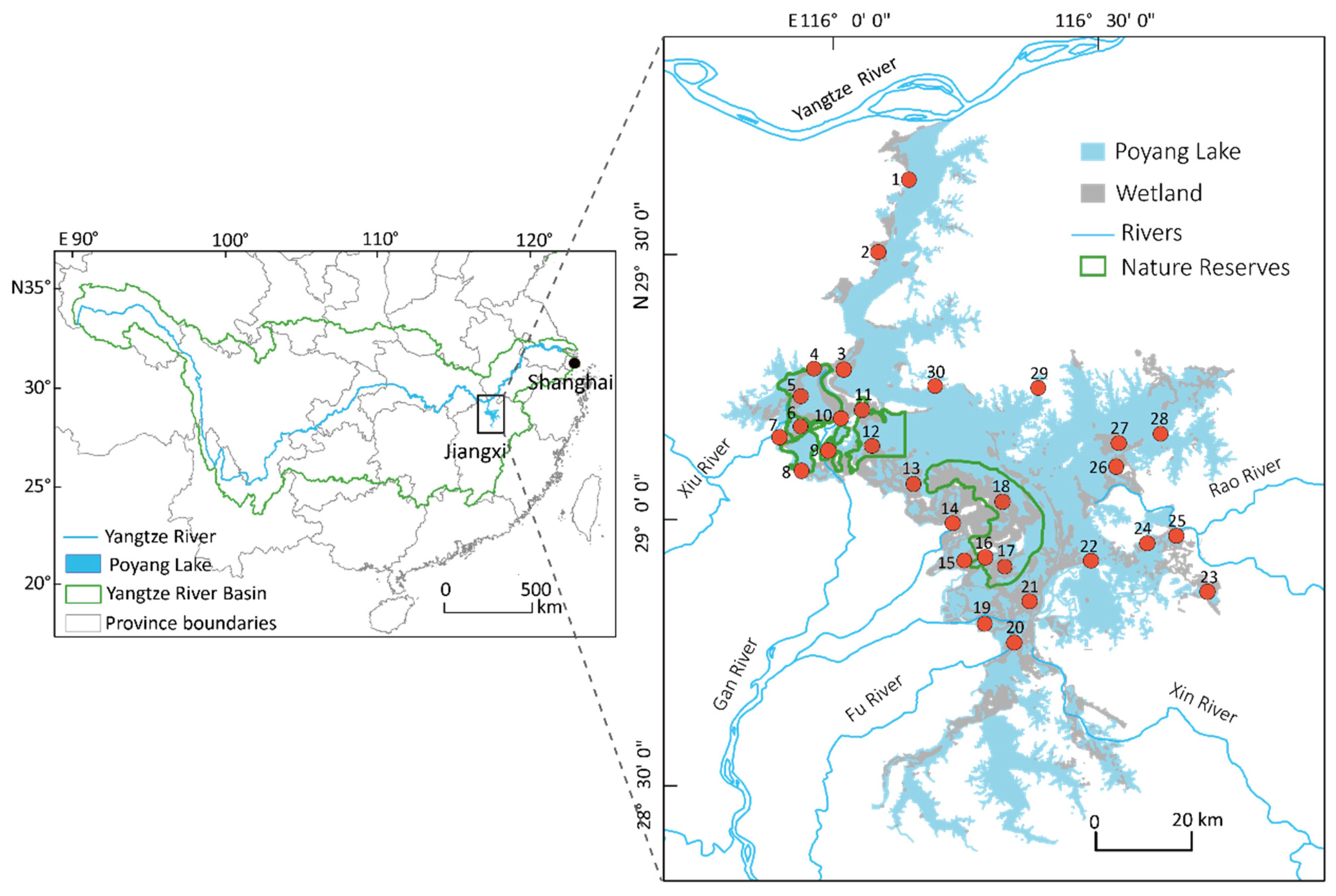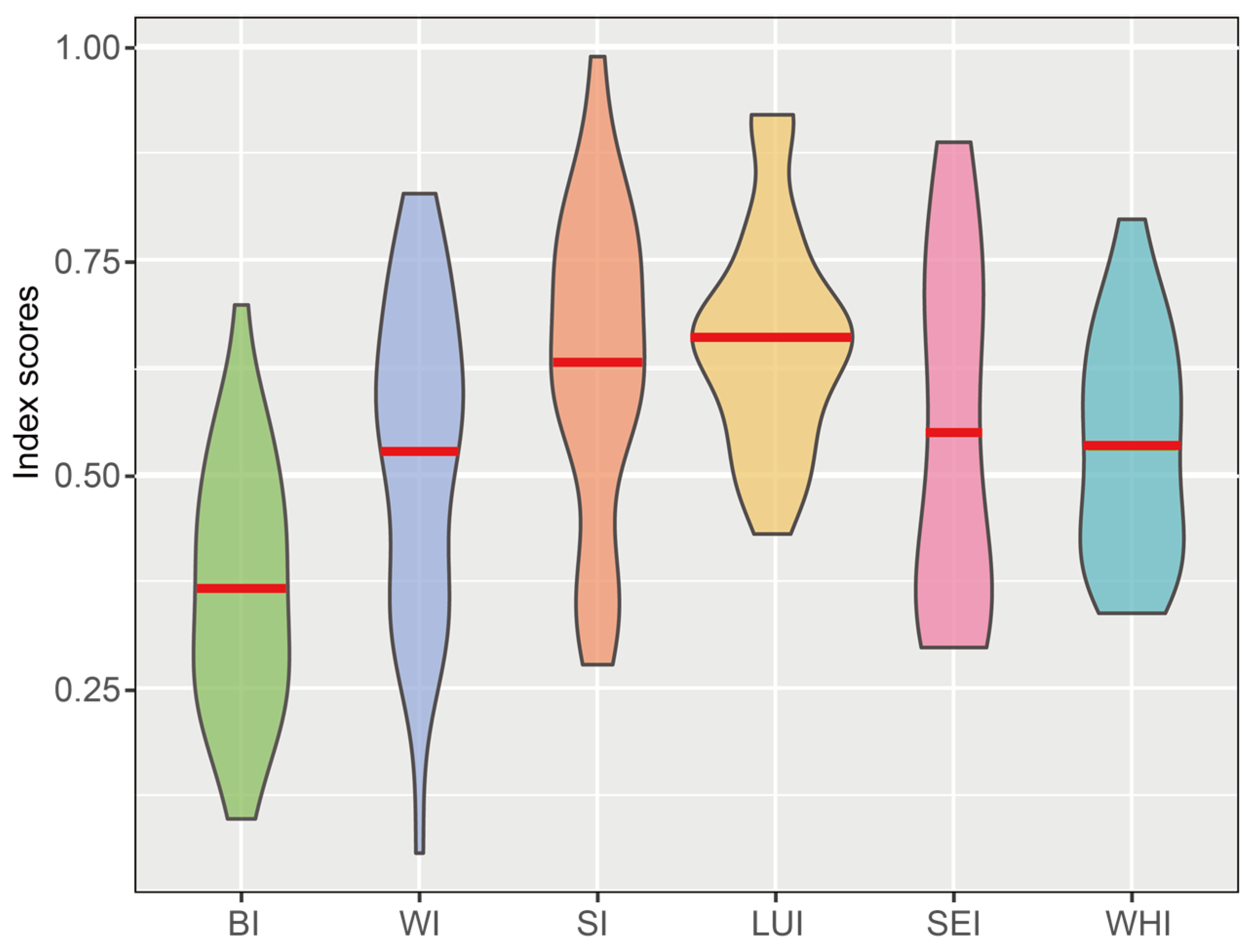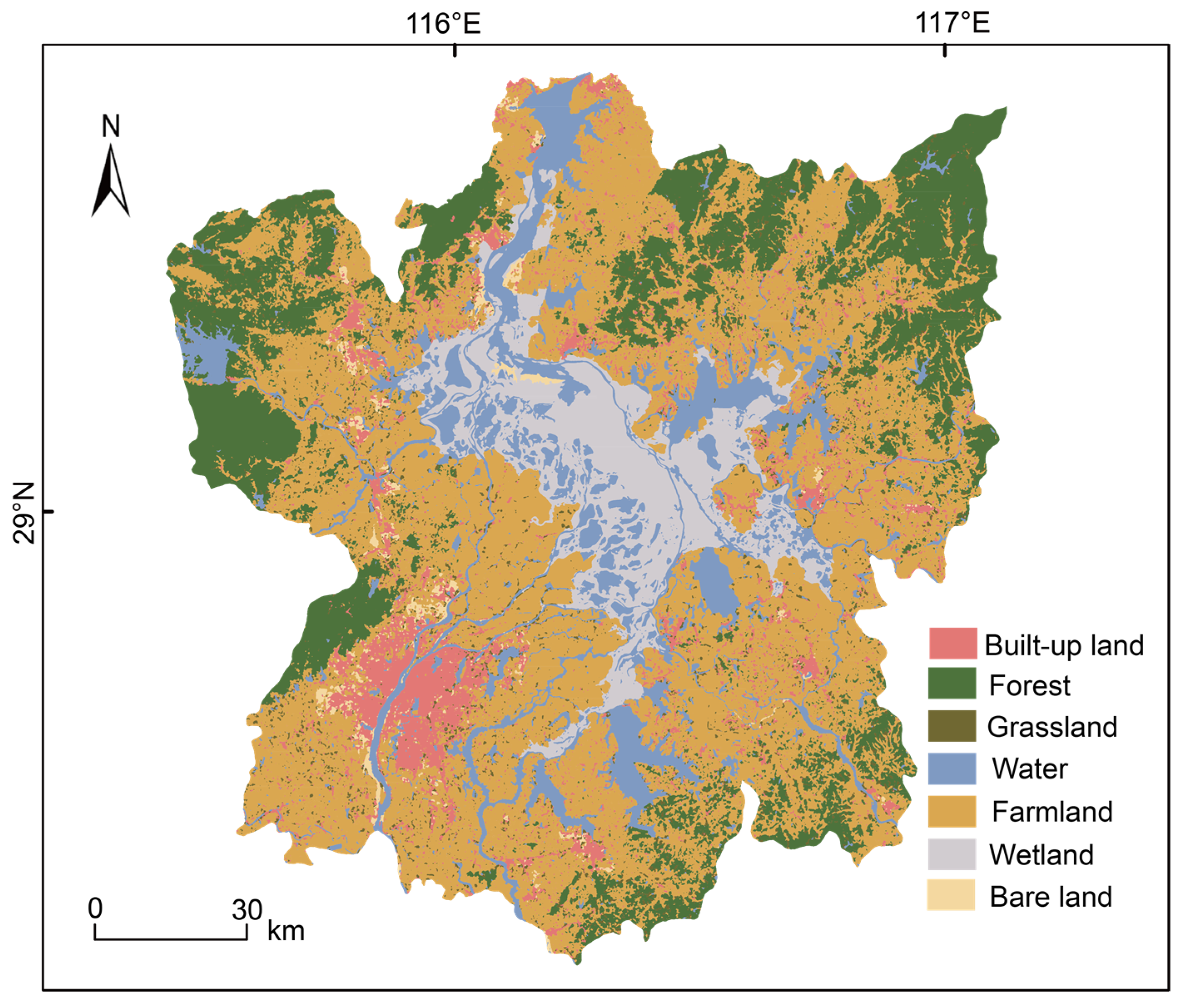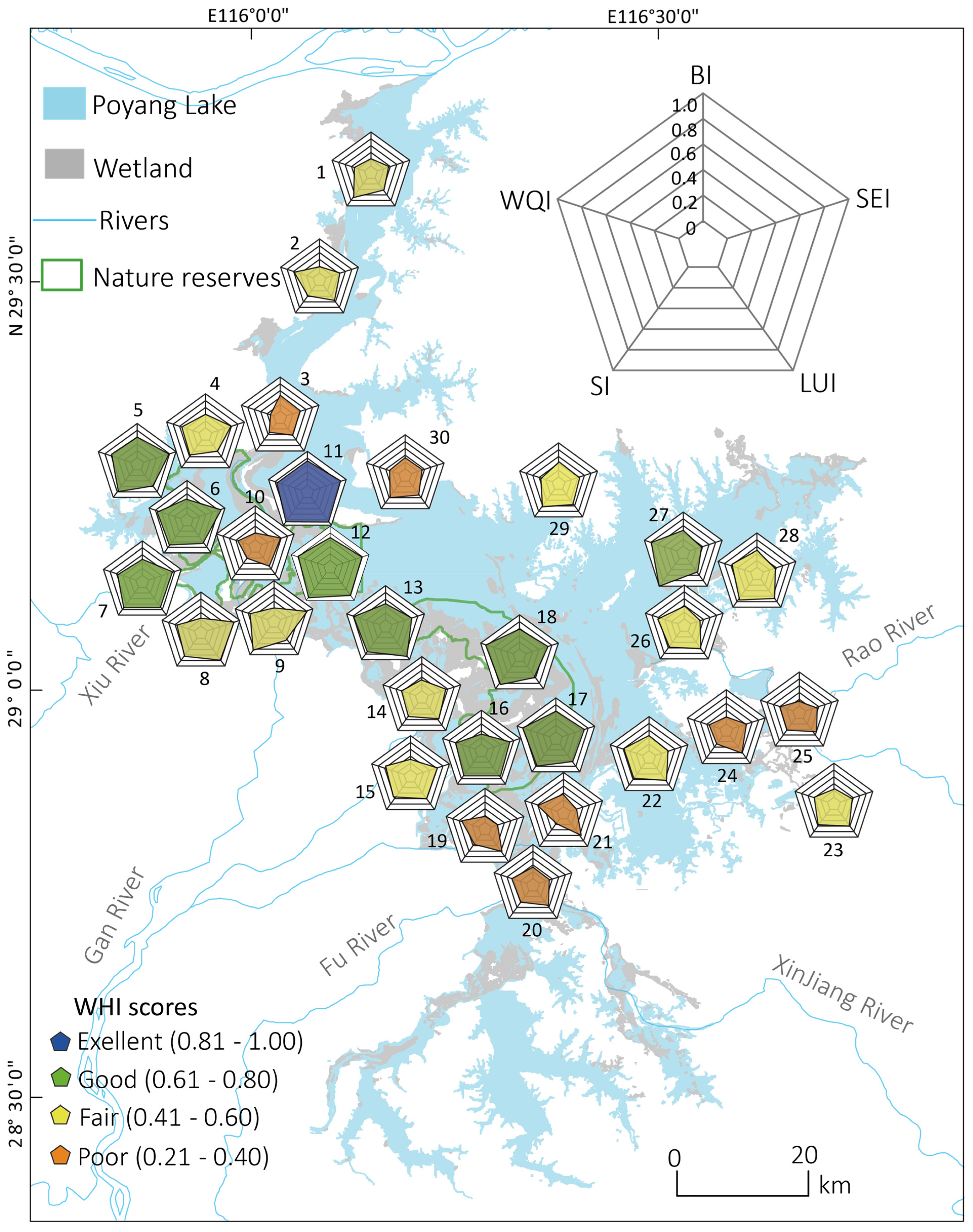A Comprehensive Multi-Metric Index for Health Assessment of the Poyang Lake Wetland
Abstract
:1. Introduction
2. Materials and Methods
2.1. Study Area
2.2. Field Surveys and Data Collections
2.2.1. Biological Variables
2.2.2. Water Quality Variables
2.2.3. Sediment Variables
2.2.4. Land Use and Remote Sensing Variables
| Variables (Abbreviation) | Description | Calculation | References |
|---|---|---|---|
| Shannon’s diversity index (SHDI) | Patch diversity in landscape | [47] | |
| Connectance index (CONNECT) | Functional connectedness of the corresponding patch type | [37,48] | |
| Aggregation index (AI) | Tendency of a particular land use type to be aggregated | [37,49] | |
| Patch density (PD) | Number of patches per unit area | [47] | |
| Largest patch index (LPI) | Percentage of total landscape area in the largest patch (%) | [47] | |
| Mean patch size (AREA_MN) | Mean size of the landscape patches | [47] | |
| Patch richness density (PRD) | Number of patch types per unit area | [47] | |
| Normalized difference vegetation index (NDVI) | Intensity of green vegetation growth in satellite images | [17] | |
| Modified normalized difference built-up index (MNDBI) | Impervious land cover in landscape | [44] |
2.2.5. Socio-Economic Variables
2.3. Metric Selection and Wetland Health Assessment
3. Results
3.1. Biological Index
3.2. Water Quality Index
3.3. Sediment Index
3.4. Land Use Index
3.5. Socio-Economic Index
3.6. Wetland Health Index (WHI)
4. Discussion
4.1. Biological Index
4.2. Water Quality Index
4.3. Sediment Index
4.4. Land Use Index
4.5. Socio-Economic Index
4.6. Comprehensive Assessment of the Poyang Lake Wetland
5. Conclusions
Author Contributions
Funding
Data Availability Statement
Conflicts of Interest
References
- Neubert, M.G.; Caswell, H. Alternatives to resilience for measuring the responses of ecological systems to perturbations. Ecology 1997, 78, 653–665. [Google Scholar] [CrossRef]
- Hu, S.; Niu, Z.; Chen, Y.; Li, L.; Zhang, H. Global wetlands: Potential distribution, wetland loss, and status. Sci. Total Environ. 2017, 586, 319–327. [Google Scholar] [CrossRef] [PubMed]
- Davidson, N.C. How much wetland has the world lost? Long-term and recent trends in global wetland area. Mar. Freshw. Res. 2014, 65, 934–941. [Google Scholar] [CrossRef]
- Fluet-Chouinard, E.; Stocker, B.D.; Zhang, Z.; Malhotra, A.; Melton, J.R.; Poulter, B.; Kaplan, J.O.; Goldewijk, K.K.; Siebert, S.; Minayeva, T.; et al. Extensive global wetland loss over the past three centuries. Nature 2023, 614, 281–286. [Google Scholar] [CrossRef] [PubMed]
- Ruaro, R.; Gubiani, É. A scientometric assessment of 30 years of the Index of Biotic Integrity in aquatic ecosystems: Applications and main flaws. Ecol. Indic. 2013, 29, 105–110. [Google Scholar] [CrossRef]
- Costanza, R. Ecosystem health and ecological engineering. Ecol. Eng. 2012, 45, 24–29. [Google Scholar] [CrossRef]
- Costanza, R.; Mageau, M. What is a healthy ecosystem? Aquat. Ecol. 1999, 33, 105–115. [Google Scholar] [CrossRef]
- Rapport, D.J.; Costanza, R.; McMichael, A.J. Assessing ecosystem health. Trends Ecol. Evol. 1998, 13, 397–402. [Google Scholar] [CrossRef]
- Schaeffer, D.J.; Herricks, E.E.; Kerster, H.W. Ecosystem health: I. Measuring ecosystem health. Environ. Manag. 1988, 12, 445–455. [Google Scholar] [CrossRef]
- Bentley, S.B.; Tomscha, S.A.; Deslippe, J.R. Indictors of wetland health improve following small-scale ecological restoration on private land. Sci. Total Environ. 2022, 837, 155760. [Google Scholar] [CrossRef]
- Burkhard, B.; Müller, F.; Lill, A. Ecosystem Health Indicators. In Ecological Indicators. Vol. [2] of Encyclopedia of Ecology; Jøgensen, S.E., Fath, B.D., Eds.; Elsevier: Oxford, UK, 2007; Volume 3, pp. 154–196. [Google Scholar]
- Zaghloul, A.; Saber, M.; Gadow, S.; Awad, F. Biological indicators for pollution detection in terrestrial and aquatic ecosystems. Bull. Natl. Res. Cent. 2020, 44, 127. [Google Scholar] [CrossRef]
- Whittier, T.R.; Stoddard, J.L.; Larsen, D.P.; Herlihy, A.T. Selecting reference sites for stream biological assessments: Best professional judgment or objective criteria. J. N. Am. Benthol. Soc. 2007, 26, 349–360. [Google Scholar] [CrossRef]
- Bhatti, S.G.; Tabinda, A.B.; Yasin, F.; Yasar, A.; Butt, H.I.; Wajahat, R. Spatio-temporal variations in physico-chemical parameters and potentially harmful elements (PHEs) of Uchalli Wetlands Complex (Ramsar site), Pakistan. Environ. Sci. Pollut. Res. 2018, 25, 33490–33507. [Google Scholar] [CrossRef]
- Xu, D.; Cai, Z.; Xu, D.; Lin, W.; Gao, J.; Li, L. Land use change and ecosystem health assessment on Shanghai-Hangzhou Bay, Eastern China. Land 2022, 11, 867. [Google Scholar] [CrossRef]
- Wang, Z.; Liu, Y.; Li, Y.; Su, Y. Response of ecosystem health to land use changes and landscape patterns in the Karst mountainous regions of Southwest China. Int. J. Environ. Res. Public Health 2022, 19, 3273. [Google Scholar] [CrossRef] [PubMed]
- Singh, M.; Sinha, R. Hydrogeomorphic indicators of wetland health inferred from multi-temporal remote sensing data for a new Ramsar site (Kaabar Tal), India. Ecol. Indic. 2021, 127, 107739. [Google Scholar] [CrossRef]
- Liu, W.; Cui, L.; Guo, Z.; Wang, D.; Zhang, M. Wetland ecosystem health improvement from ecological conservation and restoration offset the decline from socio-economic development. Land Degrad. Dev. 2023, 34, 283–295. [Google Scholar] [CrossRef]
- Chen, W.; Cao, C.; Liu, D.; Tian, R.; Wu, C.; Wang, Y.; Qian, Y.; Ma, G.; Bao, D. An evaluating system for wetland ecological health: Case study on nineteen major wetlands in Beijing-Tianjin-Hebei region, China. Sci. Total Environ. 2019, 666, 1080–1088. [Google Scholar] [CrossRef]
- You, Q.; Fang, N.; Jian, M.; Hu, Q.; Yao, B.; Liu, D.; Yang, W. A reliability-resilience-vulnerability framework for measuring the influence of changes in water level fluctuations on lake conditions. Ecol. Indic. 2022, 134, 108468. [Google Scholar] [CrossRef]
- Wu, X.; Lin, X.; Zhang, Y.; Gao, J.; Guo, L.; Li, J. Impacts of climate change on ecosystem in Priority Areas of Biodiversity Conservation in China. Chin. Sci. Bull. 2014, 59, 4668–4680. [Google Scholar] [CrossRef]
- Tullos, D. Assessing the influence of environmental impact assessments on science and policy: An analysis of the Three Gorges Project. J. Environ. Manag. 2009, 90, S208–S223. [Google Scholar] [CrossRef] [PubMed]
- Statistic Bureau of Jiangxi. Jiangxi Statistical Yearbook; China Statistic Press: Beijing, China, 2012–2021. [Google Scholar]
- Zhang, Q.; Ye, X.-C.; Werner, A.D.; Li, Y.-L.; Yao, J.; Li, X.-H.; Xu, C.-Y. An investigation of enhanced recessions in Poyang Lake: Comparison of Yangtze River and local catchment impacts. J. Hydrol. 2014, 517, 425–434. [Google Scholar] [CrossRef]
- Vondracek, B.; Koch, J.D.; Beck, M.W. A comparison of survey methods to evaluate macrophyte index of biotic integrity performance in Minnesota lakes. Ecol. Indic. 2014, 36, 178–185. [Google Scholar] [CrossRef]
- Yang, W.; You, Q.; Fang, N.; Xu, L.; Zhou, Y.; Wu, N.; Ni, C.; Liu, Y.; Liu, G.; Yang, T.; et al. Assessment of wetland health status of Poyang Lake using vegetation-based indices of biotic integrity. Ecol. Indic. 2018, 90, 79–89. [Google Scholar] [CrossRef]
- You, Q.; Yang, W.; Jian, M.; Hu, Q. A comparison of metric scoring and health status classification methods to evaluate benthic macroinvertebrate-based index of biotic integrity performance in Poyang Lake wetland. Sci. Total Environ. 2021, 761, 144112. [Google Scholar] [CrossRef]
- Gao, W.; Gao, B.; Yan, C.; Liu, Y. Evolution of anthropogenic nitrogen and phosphorus inputs to Lake Poyang Basin and its’ effect on water quality of lake. Acta Sci. Circumstantiae 2016, 36, 3137–3145. [Google Scholar]
- Ministry of Environmental Protection of the People’s Republic of China. Environmental Quality Standard for Surface Water (GB3838-2002). Available online: http://kjs.mep.gov.cn/hjbhbz/bzwb/shjbh/shjzlbz/200206/t20020601_66497.htm (accessed on 12 April 2019).
- Cai, Q.; Cao, M.; Huang, X. Protocols for Standard Observation and Measurement in Aquatic Ecosystems; China Environmental Science Press: Beijing, China, 2007. [Google Scholar]
- Xie, X.; Fang, B.; Xu, H.; He, S.; Li, X. Study on the coordinated relationship between urban land use efficiency and ecosystem health in China. Land Use Policy 2021, 102, 105235. [Google Scholar] [CrossRef]
- Heller, N.E.; McManus Chauvin, K.; Skybrook, D.; Barnosky, A.D. Including stewardship in ecosystem health assessment. Nat. Sustain. 2023, 6, 731–741. [Google Scholar] [CrossRef]
- Gorelick, N.; Hancher, M.; Dixon, M.; Ilyushchenko, S.; Thau, D.; Moore, R. Google Earth Engine: Planetary-scale geospatial analysis for everyone. Remote Sens. Environ. 2017, 202, 18–27. [Google Scholar] [CrossRef]
- Uzarski, D.G.; Burton, T.M.; Cooper, M.J.; Ingram, J.W.; Timmermans, S.T. Fish habitat use within and across wetland classes in coastal wetlands of the five Great Lakes: Development of a fish-based index of biotic integrity. J. Great Lakes Res. 2005, 31, 171–187. [Google Scholar] [CrossRef]
- Liu, D.; Liu, L.; You, Q.; Hu, Q.; Jian, M.; Liu, G.; Cong, M.; Yao, B.; Xia, Y.; Zhong, J.; et al. Development of a landscape-based multi-metric index to assess wetland health of the Poyang Lake. Remote Sens. 2022, 14, 1082. [Google Scholar] [CrossRef]
- Huang, W.; Mao, J.; Zhu, D.; Lin, C. Impacts of land use and land cover on water quality at multiple buffer-zone scales in a lakeside city. Water 2020, 12, 47. [Google Scholar] [CrossRef]
- Zhang, L.; Hou, G.; Li, F. Dynamics of landscape pattern and connectivity of wetlands in western Jilin Province, China. Environ. Dev. Sustain. 2020, 22, 2517–2528. [Google Scholar] [CrossRef]
- Sun, T.; Lin, W.; Chen, G.; Guo, P.; Zeng, Y. Wetland ecosystem health assessment through integrating remote sensing and inventory data with an assessment model for the Hangzhou Bay, China. Sci. Total Environ. 2016, 566–567, 627–640. [Google Scholar] [CrossRef]
- Jafary, P.; Sarab, A.A.; Tehrani, N.A. Ecosystem health assessment using a fuzzy spatial decision support system in Taleghan Watershed before and after dam construction. Environ. Process. 2018, 5, 807–831. [Google Scholar] [CrossRef]
- Wu, C.; Chen, W. Indicator system construction and health assessment of wetland ecosystem—Taking Hongze Lake Wetland, China as an example. Ecol. Indic. 2020, 112, 106164. [Google Scholar] [CrossRef]
- Mohibul, S.; Sarif, M.N.; Parveen, N.; Khanam, N.; Siddiqui, M.A.; Naqvi, H.R.; Nasrin, T.; Siddiqui, L. Wetland health assessment using DPSI framework: A case study in Kolkata Metropolitan Area. Environ. Sci. Pollut. Res. 2023. [Google Scholar] [CrossRef]
- Skidmore, A.K.; Coops, N.C.; Neinavaz, E.; Ali, A.; Schaepman, M.E.; Paganini, M.; Kissling, W.D.; Vihervaara, P.; Darvishzadeh, R.; Feilhauer, H.; et al. Priority list of biodiversity metrics to observe from space. Nat. Ecol. Evol. 2021, 5, 896–906. [Google Scholar] [CrossRef]
- Higgins, S.I.; Conradi, T.; Muhoko, E. Shifts in vegetation activity of terrestrial ecosystems attributable to climate trends. Nat. Geosci. 2023, 16, 147–153. [Google Scholar] [CrossRef]
- Hu, Y. Investigation of a modified normalized built-up undex and a post processing scheme for BUILT-UP extraction in urban area. Geomat. Sci. Technol. 2017, 5, 83–92. [Google Scholar] [CrossRef]
- Hou, Y.; Ding, W.; Liu, C.; Li, K.; Cui, H.; Liu, B.; Chen, W. Influences of impervious surfaces on ecological risks and controlling strategies in rapidly urbanizing regions. Sci. Total Environ. 2022, 825, 153823. [Google Scholar] [CrossRef] [PubMed]
- Gupta, S.; Islam, S.; Hasan, M. Analysis of impervious land-cover expansion using remote sensing and GIS: A case study of Sylhet sadar upazila. Appl. Geogr. 2018, 98, 156–165. [Google Scholar] [CrossRef]
- McGarigal, K.; Marks, B.J. FRAGSTATS: Spatial Pattern Analysis Program for Quantifying Landscape Structure; U.S. Department of Agriculture, Forest Service, Pacific Northwest Research Station: Washington, DC, USA, 1995.
- Spanowicz, A.G.; Jaeger, J.A.G. Measuring landscape connectivity: On the importance of within-patch connectivity. Landsc. Ecol. 2019, 34, 2261–2278. [Google Scholar] [CrossRef]
- He, H.S.; DeZonia, B.E.; Mladenoff, D.J. An aggregation index (AI) to quantify spatial patterns of landscapes. Landsc. Ecol. 2000, 15, 591–601. [Google Scholar] [CrossRef]
- Faridah-Hanum, I.; Yusoff, F.M.; Fitrianto, A.; Ainuddin, N.A.; Gandaseca, S.; Zaiton, S.; Norizah, K.; Nurhidayu, S.; Roslan, M.; Hakeem, K.R.; et al. Development of a comprehensive mangrove quality index (MQI) in Matang Mangrove: Assessing mangrove ecosystem health. Ecol. Indic. 2019, 102, 103–117. [Google Scholar] [CrossRef]
- Wu, N.; Cai, Q.; Fohrer, N. Development and evaluation of a diatom-based index of biotic integrity (D-IBI) for rivers impacted by run-of-river dams. Ecol. Indic. 2012, 18, 108–117. [Google Scholar] [CrossRef]
- Costa, P.; Schulz, U. The fish community as an indicator of biotic integrity of the streams in the Sinos River basin, Brazil. Braz. J. Biol. 2010, 70, 1195–1205. [Google Scholar] [CrossRef]
- Raphahlelo, M.E.; Addo-Bediako, A.; Luus-Powell, W.J. Distribution and diversity of benthic macroinvertebrates in the Mohlapitsi River, South Africa. J. Freshw. Ecol. 2022, 37, 145–160. [Google Scholar] [CrossRef]
- Yamashina, C.; Hara, M.; Fujita, T. The effects of human disturbance on the species composition, species diversity and functional diversity of a Miombo woodland in northern Malawi. Afr. J. Ecol. 2021, 59, 216–224. [Google Scholar] [CrossRef]
- Li, B.; Yang, G.; Wan, R. Multidecadal water quality deterioration in the largest freshwater lake in China (Poyang Lake): Implications on eutrophication management. Environ. Pollut. 2020, 260, 114033. [Google Scholar] [CrossRef]
- Fang, N.; You, Q.; Yang, W.; Xu, L.; Zhou, Y.; Ni, C. Eutrophication and Water Quality Assessment in the Poyang Lake Wetlands. In Chinese Water System Volume 3: Poyang Lake Basin; Yue, T., Nixdorf, E., Zhou, C., Xu, B., Zhao, N., Fan, Z., Huang, X., Chen, C., Kolditz, O., Eds.; Springer: Berlin/Heidelberg, Germany, 2018; pp. 91–98. [Google Scholar]
- Kakade, A.; Salama, E.-S.; Han, H.; Zheng, Y.; Kulshrestha, S.; Jalalah, M.; Harraz, F.A.; Alsareii, S.A.; Li, X. World eutrophic pollution of lake and river: Biotreatment potential and future perspectives. Environ. Technol. Innov. 2021, 23, 101604. [Google Scholar] [CrossRef]
- Jin, X.; Xu, Q.; Huang, C. Current status and future tendency of lake eutrophication in China. Sci. China Ser. C Life Sci. 2005, 48, 948–954. [Google Scholar]
- Qin, B.; Zhang, Y.; Zhu, G.; Gao, G. Eutrophication control of large shallow lakes in China. Sci. Total Environ. 2023, 881, 163494. [Google Scholar] [CrossRef]
- Zhang, D.; Wang, P.; Cui, R.; Yang, H.; Li, G.; Chen, A.; Wang, H. Electrical conductivity and dissolved oxygen as predictors of nitrate concentrations in shallow groundwater in Erhai Lake region. Sci. Total Environ. 2022, 802, 149879. [Google Scholar] [CrossRef]
- Koehnken, L.; Rintoul, M.S.; Goichot, M.; Tickner, D.; Loftus, A.-C.; Acreman, M.C. Impacts of riverine sand mining on freshwater ecosystems: A review of the scientific evidence and guidance for future research. River Res. Appl. 2020, 36, 362–370. [Google Scholar] [CrossRef]
- Wu, Z. The Influence of River-lake Relation Change on the Poyang Lake Sediments Nitrogen/Phosphorus Form and Release Risk. Master’s Thesis, Nanchang University, Nanchang, China, 2014. [Google Scholar]
- Wang, M.; Liu, J.; Lai, J. Metals Pollution and Ecological Risk Assessment of Sediments in the Poyang Lake, China. Bull. Environ. Contam. Toxicol. 2019, 102, 511–518. [Google Scholar] [CrossRef] [PubMed]
- Feng, Y.; Chenglin, L.; Bowen, W. Evaluation of heavy metal pollution in the sediment of Poyang Lake based on stochastic geo-accumulation model (SGM). Sci. Total Environ. 2019, 659, 1–6. [Google Scholar] [CrossRef]
- Jennings, S.; Kaiser, M.J. The Effects of Fishing on Marine Ecosystems. In Advances in Marine Biology; Blaxter, J.H.S., Southward, A.J., Tyler, P.A., Eds.; Academic Press: Cambridge, MA, USA, 1998; Volume 34, pp. 201–352. [Google Scholar]
- Wang, H.; Wang, P.; Xu, C.; Sun, Y.; Shi, L.; Zhou, L.; Jeppesen, E.; Chen, J.; Xie, P. Can the “Ten-Year Fishing Ban” rescue biodiversity of the Yangtze River? Innovation 2022, 3, 100235. [Google Scholar]
- Ren, Y.; Zhang, F.; Li, J.; Zhao, C.; Jiang, Q.; Cheng, Z. Ecosystem health assessment based on AHP-DPSR model and impacts of climate change and human disturbances: A case study of Liaohe River Basin in Jilin Province, China. Ecol. Indic. 2022, 142, 109171. [Google Scholar] [CrossRef]
- Agbede, E.A.; Bani, Y.; Azman-Saini, W.N.W.; Naseem, N.A.M. The impact of energy consumption on environmental quality: Empirical evidence from the MINT countries. Environ. Sci. Pollut. Res. 2021, 28, 54117–54136. [Google Scholar] [CrossRef]




| Dataset | Spatial Resolution | Acquisition Date | Number | Source |
|---|---|---|---|---|
| Landsat 8 OLI Surface Reflectance | 30 m | 19 August 2019 20 September 2019 11 September 2019 | Path 121, Row 39 Path 121, Row 40 Path 122, Row 40 | The United States Geological Survey (https://earthexplorer.usgs.gov) |
| Sentinel-2 Level 2A | 10 m (Bands 4, 8) 20 m (Band 12) | 2 October 2019 2 October 2019 19 October 2019 19 October 2019 | 50RLT 50RLS 50RMT 50RMS | GEE catalogue [33] |
| Variables | PC1 | PC2 | PC3 | PC4 |
|---|---|---|---|---|
| Number of macrophyte species | 0.02 | 0.71 | 0.49 | 0.15 |
| Macrophyte Shannon–Wiener index | 0.45 | 0.86 | 0.05 | 0.18 |
| Number of invasive macrophyte species | −0.43 | 0.10 | 0.74 | 0.27 |
| Number of submerged species | 0.48 | 0.73 | −0.23 | −0.3 |
| Number of tolerant macrophyte species | 0.53 | −0.22 | −0.6 | 0.24 |
| Number of benthic macroinvertebrate taxa | 0.81 | −0.15 | 0.05 | 0.19 |
| Number of predator taxa | 0.82 | −0.11 | 0.20 | 0.10 |
| Percent of Diptera | 0.07 | 0.58 | −0.34 | 0.53 |
| Density of benthic macroinvertebrates | −0.57 | 0.14 | −0.23 | 0.58 |
| Benthic macroinvertebrate Shannon–Wiener index | 0.89 | −0.22 | 0.25 | 0.19 |
| Average score per taxon index | 0.80 | −0.16 | 0.26 | 0.12 |
| Proportion of variance | 0.38 | 0.21 | 0.14 | 0.09 |
| Cumulative proportion | 0.38 | 0.59 | 0.73 | 0.82 |
| Variables | PC1 | PC2 | PC3 |
|---|---|---|---|
| pH | 0.02 | 0.43 | −0.33 |
| Total suspended solids | 0.54 | −0.16 | −0.20 |
| Electrical conductivity | 0.54 | −0.17 | −0.21 |
| Dissolved oxygen | −0.08 | 0.48 | −0.05 |
| Total phosphorus | 0.12 | 0.51 | 0.26 |
| Ammonium nitrogen | 0.33 | −0.17 | 0.30 |
| Nitrate nitrogen | 0.28 | 0.37 | 0.28 |
| Total nitrogen | 0.37 | 0.27 | 0.37 |
| Chlorophyll a | −0.24 | −0.19 | 0.34 |
| Biochemical oxygen demand in manganese | 0.41 | −0.16 | −0.16 |
| Proportion of variance | 0.44 | 0.21 | 0.12 |
| Cumulative proportion | 0.44 | 0.65 | 0.77 |
| Variables | PC1 | PC2 | PC3 |
|---|---|---|---|
| Total nitrogen | 0.32 | 0.64 | 0.39 |
| Total phosphorus | 0.68 | 0.44 | −0.02 |
| Total organic carbon | −0.02 | −0.59 | 0.42 |
| Cu | 0.43 | −0.24 | 0.53 |
| Zn | 0.45 | −0.24 | −0.25 |
| Cd | 0.38 | −0.12 | 0.03 |
| Pb | 0.35 | −0.19 | −0.47 |
| Proportion of variance | 0.36 | 0.25 | 0.14 |
| Cumulative proportion | 0.36 | 0.61 | 0.75 |
| Variables | PC1 | PC2 | PC3 | PC4 |
|---|---|---|---|---|
| Percent of farmland | 0.11 | 0.22 | −0.62 | 0.06 |
| Percent of forest | 0.09 | 0.17 | −0.06 | −0.83 |
| Percent of built-up land | 0.30 | −0.19 | −0.24 | −0.09 |
| Shannon’s diversity index | 0.43 | −0.12 | 0.14 | −0.05 |
| Connectance index | 0.01 | 0.56 | 0.18 | 0.03 |
| Patch richness density | −0.32 | 0.34 | 0.21 | 0.18 |
| Patch density | 0.35 | 0.40 | 0.13 | 0.13 |
| Largest patch index | −0.36 | 0.26 | −0.13 | 0.11 |
| Mean patch size | −0.30 | −0.34 | −0.03 | 0.01 |
| Aggregation index | −0.40 | −0.20 | −0.14 | −0.07 |
| NDVI | 0.25 | −0.04 | −0.39 | 0.44 |
| MNDBI | 0.18 | −0.24 | 0.50 | 0.19 |
| Proportion of variance | 0.38 | 0.18 | 0.15 | 0.10 |
| Cumulative proportion | 0.38 | 0.56 | 0.71 | 0.81 |
| Variables | PC1 | PC2 | PC3 |
|---|---|---|---|
| Population density | 0.20 | 0.60 | −0.62 |
| GDP | 0.10 | 0.95 | 0.21 |
| GDP per capita | −0.59 | 0.72 | −0.01 |
| Total energy consumption | 0.70 | −0.48 | −0.19 |
| Unit GDP energy consumption | −0.31 | −0.27 | 0.85 |
| Environmental protection investment | 0.62 | −0.58 | 0.02 |
| Total output of aquatic products | 0.98 | 0.11 | 0.07 |
| Average ordinary high school students per 10,000 population | 0.47 | 0.20 | 0.63 |
| Chemical fertilization intensity | 0.70 | 0.67 | 0.12 |
| Proportion of variance | 0.45 | 0.26 | 0.10 |
| Cumulative proportion | 0.45 | 0.71 | 0.81 |
| BI | WI | SI | LUI | SEI | |
|---|---|---|---|---|---|
| WI | 0.58 *** | - | - | - | - |
| SI | 0.67 *** | 0.69 *** | - | - | - |
| LUI | 0.31 ns | 0.51 ** | 0.29 ns | - | - |
| SEI | 0.34 ns | 0.45 ** | 0.50 ** | 0.48 ** | - |
| WHI | 0.74 *** | 0.91 *** | 0.85 *** | 0.63 *** | 0.68 *** |
Disclaimer/Publisher’s Note: The statements, opinions and data contained in all publications are solely those of the individual author(s) and contributor(s) and not of MDPI and/or the editor(s). MDPI and/or the editor(s) disclaim responsibility for any injury to people or property resulting from any ideas, methods, instructions or products referred to in the content. |
© 2023 by the authors. Licensee MDPI, Basel, Switzerland. This article is an open access article distributed under the terms and conditions of the Creative Commons Attribution (CC BY) license (https://creativecommons.org/licenses/by/4.0/).
Share and Cite
Yang, W.; Zhong, J.; Xia, Y.; Hu, Q.; Fang, C.; Cong, M.; Yao, B.; You, Q. A Comprehensive Multi-Metric Index for Health Assessment of the Poyang Lake Wetland. Remote Sens. 2023, 15, 4061. https://doi.org/10.3390/rs15164061
Yang W, Zhong J, Xia Y, Hu Q, Fang C, Cong M, Yao B, You Q. A Comprehensive Multi-Metric Index for Health Assessment of the Poyang Lake Wetland. Remote Sensing. 2023; 15(16):4061. https://doi.org/10.3390/rs15164061
Chicago/Turabian StyleYang, Wenjing, Jie Zhong, Ying Xia, Qiwu Hu, Chaoyang Fang, Mingyang Cong, Bo Yao, and Qinghui You. 2023. "A Comprehensive Multi-Metric Index for Health Assessment of the Poyang Lake Wetland" Remote Sensing 15, no. 16: 4061. https://doi.org/10.3390/rs15164061
APA StyleYang, W., Zhong, J., Xia, Y., Hu, Q., Fang, C., Cong, M., Yao, B., & You, Q. (2023). A Comprehensive Multi-Metric Index for Health Assessment of the Poyang Lake Wetland. Remote Sensing, 15(16), 4061. https://doi.org/10.3390/rs15164061






